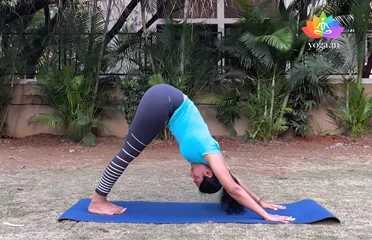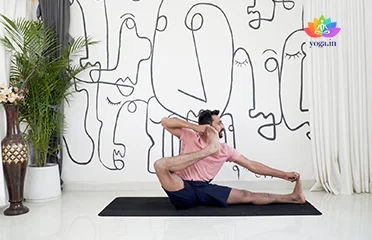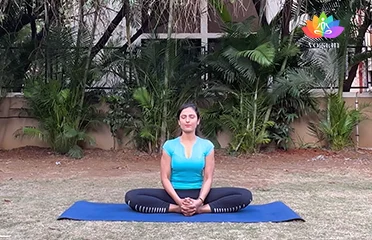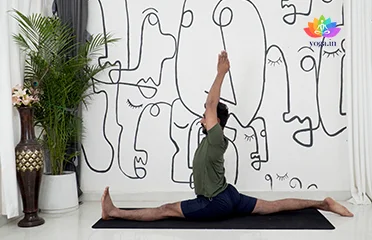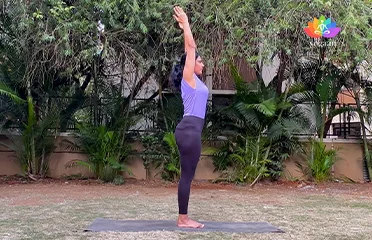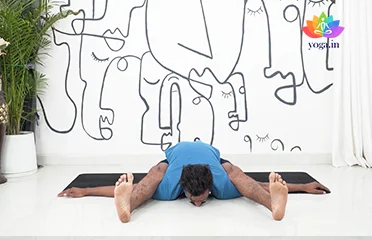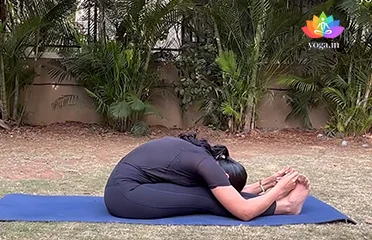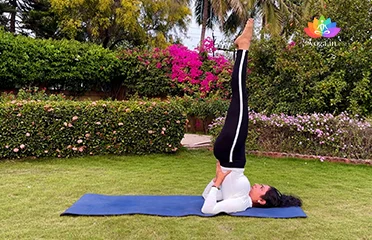Adho Mukha Svanasana (Downward-Facing Do
अधोमुख श्वानासन / Downward-Facing Dog Pose
The sanskrit name is derived from adhas (अधस्) meaning down, mukha [�K]
Akarna Dhanurasana (Archer Pose)
अकर्णा धनुरासन / Archer Pose
The Sanskrit name is derived from Akarna (अकर्णा ) meaning towards [�K]
Bhadrasana (Gracious Pose | Butterfly Po
भद्रासन / Gracious Pose | Butterfly Pose
The Sanskrit name is derived from Bhadra (भद्रा) meaning gracious, [�K]
Hanumanasana (Monkey Pose)
हनुमानासन / Monkey Pose
The Sanskrit name is derived from the Hindu God -Hanuman (हनुमान) [�K]
Hastapadasana (Hand to Foot Pose)
हस्तपदासन / Hand to Foot Pose
The sanskrit name is derived from hasta (हस्त) means hands, pada (पदा) [�K]
Kurmasana (Tortoise Pose)
कूर्मासन / Tortoise Pose
The Sanskrit name is derived from Kurma (कूर्मा) meaning tortoise [�K]
Naukasana (Boat Pose)
नौकासन / Boat Pose
The Sanskrit name is derived from Nava ( नाव) meaning boat and asana (आसन) [�K]
Paschimottanasana (Seated Forward Bend)
पश्चिमोत्तानासन / Seated Forward Bend
The Sanskrit name is derived from three sanskrit words: Paschima (पश्चिमा) [�K]
Pincha Mayurasana (Peacock Feather Pose)
पिंचमयूरासन / Peacock Feather Pose
The Sanskrit name is derived from Pincha (पिंच) meaning feathered, Mayur [�K]
Sarvangasana (Shoulderstand)
सर्वाङ्गासनI / Shoulderstand
The Sanskrit name is derived from Sarva (सर्वाङ्ग) meaning all, [�K]
- 1
- 2
How Yoga Can Help Cure Hernia:
A hernia occurs when an organ or tissue pushes through a weak spot in the surrounding muscle or connective tissue. Yoga can help manage and alleviate the symptoms of a hernia by strengthening the abdominal muscles, improving body posture, and promoting relaxation. Through specific postures, breathing exercises, and gentle stretching, yoga can enhance physical health and support the body’s natural healing processes.
Understanding Hernia:
A hernia is a condition where an internal part of the body, such as an organ or tissue, protrudes through a weakened area in the muscle or surrounding tissue wall. Common types of hernia include inguinal (inner groin), umbilical (belly button), hiatal (upper stomach), and incisional (resulting from an incision). Hernias can cause pain, discomfort, and complications if not managed properly.
Yoga’s Role in Relieving Hernia:
Specific yoga practices can help alleviate the symptoms of a hernia by strengthening the abdominal muscles, reducing strain, and improving overall well-being. Gentle asanas (postures), pranayama (breathing exercises), and relaxation techniques can promote muscle health, enhance circulation, and reduce stress, which can help manage hernia symptoms effectively.
Key Factors Contributing to Hernia:
Several factors can contribute to the development of a hernia, including:
- Weak Abdominal Muscles: A lack of strength in the abdominal muscles can lead to hernias.
- Heavy Lifting: Straining the abdominal area while lifting heavy objects.
- Chronic Coughing: Persistent coughing can increase abdominal pressure.
- Obesity: Excess body weight can put pressure on the abdominal wall.
- Pregnancy: The added pressure on the abdomen during pregnancy.
- Constipation: Straining during bowel movements can cause hernias.
Symptoms of Hernia:
Common symptoms of a hernia include:
- Visible Bulge: A noticeable bulge in the affected area, often more pronounced when standing or straining.
- Pain or Discomfort: Pain or discomfort at the hernia site, especially when bending over, coughing, or lifting.
- Feeling of Heaviness: A feeling of heaviness or pressure in the abdomen.
- Burning Sensation: A burning or aching sensation at the bulge site.
- Nausea or Vomiting: In severe cases, hernias can cause nausea or vomiting.
- Difficulty Swallowing: For hiatal hernias, difficulty swallowing can occur.
Treatment of Hernia through Yoga and Pranayama:
Yoga and pranayama can be beneficial in managing hernia symptoms. Some effective practices include:
Specific Yoga Poses:
- Tadasana (Mountain Pose): Helps improve posture and strengthen the abdominal muscles.
- Vajrasana (Thunderbolt Pose): Promotes digestion and reduces strain on the abdomen.
Pranayama Exercises:
- Anulom Vilom (Alternate Nostril Breathing): Balances the body and reduces stress.
- Bhramari (Bee Breath): Calms the mind and reduces tension.
Diet for Hernia:
A balanced diet can help manage hernia symptoms. Recommendations include:
- High-Fiber Foods: Whole grains, fruits, and vegetables to prevent constipation.
- Lean Proteins: Chicken, fish, and legumes for muscle health.
- Hydration: Drinking plenty of water to stay hydrated and support digestion.
- Anti-Inflammatory Foods: Ginger, turmeric, and green leafy vegetables to reduce inflammation.
- Small, Frequent Meals: Eating smaller, more frequent meals to reduce abdominal pressure.
Caution for Hernia:
While practicing yoga for hernia, it is essential to:
- Avoid Overexertion: Practice at a gentle pace to prevent strain on the abdomen.
- Be Mindful of Pain: Stop immediately if any pose causes discomfort or pain.
Always consult with a healthcare provider before starting any new exercise regimen, especially if you have a hernia.
Contraindications for Hernia:
Individuals with severe hernia or significant abdominal pain should:
- Avoid Intense Yoga Practices: Vigorous exercises might exacerbate symptoms.
- Steer Clear of Certain Poses: Inversions and poses that compress the abdomen may increase discomfort.
- Seek Professional Guidance: Consult a yoga therapist or healthcare professional for personalized recommendations.


